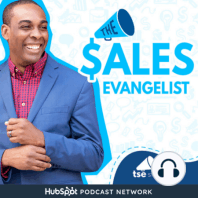8 min listen

TSE 1076: Holding Prescriptive Conversations With Buyers
TSE 1076: Holding Prescriptive Conversations With Buyers
ratings:
Length:
33 minutes
Released:
Apr 19, 2019
Format:
Podcast episode
Description
Sellers can guide prospective customers through the purchasing journey by holding prescriptive conversations with buyers. Tom Pisello launched into the topic of prescriptives because he was a product manager who was launching products in the marketplace, with a sales force that had never engaged these particular customers. In an attempt to help buyers make decisions, he created prescriptive tools that would help customers analyze their existing situation and compare it to the new product. Buyer frustration The B2B purchase decision is more challenging than ever for buyers because there are six to 10 decision makers in every decision. Buyers spend incredible amounts of time on their own gathering, processing, and deconflicting information. And 94 percent of buyers have participated in a buying cycle that just evaporated. Buyers are frustrated. About 84 percent report that the buyers' journey is taking longer than they expected. There's a big opportunity for sellers as well as a challenge for them to overcome: to help buyers through a journey that has become much tougher and longer than ever before. The problem is that most sellers show up to meetings talking about themselves: about the company, the product, the services, themselves, and the customers they are working with. Then when the competition shows up for their meeting, they do the same thing. They all sound exactly the same, so the buying process becomes a shootout. Flip it around Instead of talking about the typical things, talk about the challenges the prospect might be having. Then, use that to do some teaching about the challenges you're seeing at other companies. Then, pivot to a Socratic approach. Ask probing, diagnosing questions to identify whether your prospects see themselves in the other customers you described. Do a little bit of cooperative discovery. If you sell office furniture, start by sharing current research about what makes a good office setup. Is open office the way to go? What about standup desks? Instead of pitching yourself or your product, share information about productive office environments. Talk about the challenges of collaboration and flexible work environments. Mention health and engagement. Talk provocatively about these challenges and how they affect your prospect. The book The Challenger Sale by Matthew Dixon and Brent Adamson tackles this approach well. Share examples This leads naturally into you sharing stories and examples about how you've helped other customers with their office furniture needs and about how successful they've been as a result. From there you'll use the Socratic method to dig deep. Be careful how much of a challenge you present early on because it's possible that you haven't earned the right to do that. Start with something provocative, but then pivot away from the research to your questions. The goal is to move into a collaboration with the customer. Guide the customer Buyers prefer this process because you're solving a problem and uncovering problems they didn't even realize they had. But even for issues they knew they had, you're putting some numbers to them. You're clarifying how their employees will be impacted by the purchase of office furniture. That's why pivoting from research to personal is important. You're putting it into a perspective your customer can understand and telling the customer exactly what the problem is costing and how you can help solve it. You're helping them to prioritize all of these challenges and becoming a prescriptive consultant to them. As a seller, it's your moral obligation to act as a guide to the customer. Because the buyer's journey has gotten complicated, you need to provide a map of sorts so the customer knows what to expect. Then be prepared to proactively provide information to the buyer along the way. If you know the company will ask for a business case, proactively provide it. Don't wait for the customer to ask. [Tweet "Be an evolved seller who is ready for requests tha
Released:
Apr 19, 2019
Format:
Podcast episode
Titles in the series (100)
TSE 000: Welcome to the Sales Evangelist Podcast! by The Sales Evangelist